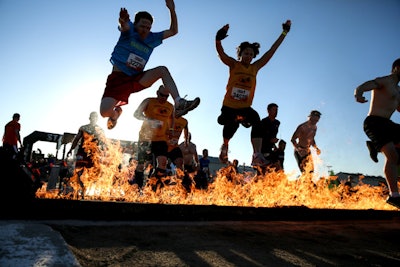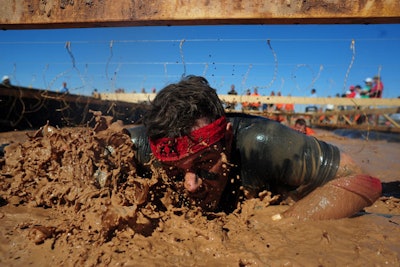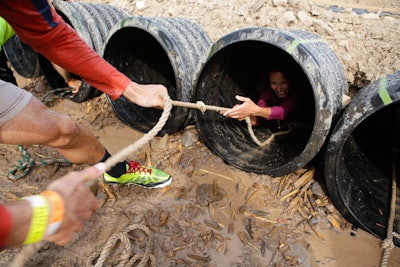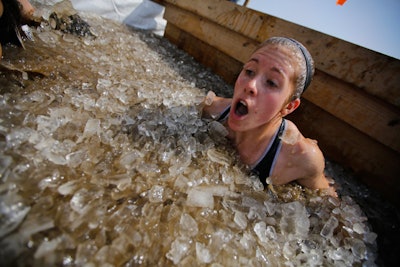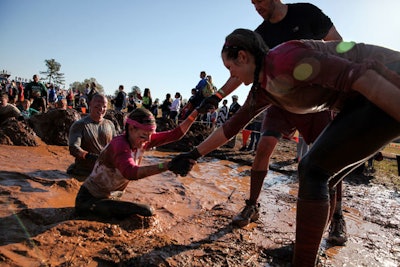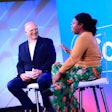If you haven’t run, jumped, and dragged yourself through a Tough Mudder obstacle course, it’s likely that you’ve seen Facebook photos of friends and acquaintances who have: They’re scaling 10-foot walls, running through a field of live electrical wires, or crawling through puddles under barbed wire. Or they’re smiling at the finish line, covered in mud, looking tired and a little smug after the 10- to 12-mile course.
Those photos are a big part of Tough Mudder’s marketing plan and its rapid growth. Since Harvard Business School grad Will Dean launched the company with three events in 2010, Tough Mudder has grown to producing 53 events for 750,000 participants in 2013, expanding to Canada, the United Kingdom, Germany, and Australia along the way. The brand expects to host more than 60 events in 2014.
Social media has been “absolutely crucial” to that growth, says Alex Patterson, Tough Mudder’s vice president of culture. (He’s in charge of maintaining its corporate ethos, with a focus on business innovation and personal growth, after serving as chief creative officer and chief marketing officer for the downtown Brooklyn-based company.) “There’s no way that we could have grown the way we grew without social media and without people having the opportunity to see a photo, press ‘Like,’ click through to the person and ask if they’re doing it next year, and if they want to be on a team.”
The notion of encouraging participants to share their Tough Mudder experience permeates everything from ad spending to the design of the courses. “Tough Mudder has been crafted to be the story you tell at the water cooler on Monday,” Patterson says. When someone asks, “What did you do this weekend?” jumping into dumpster of ice water isn’t the typical answer.
The obstacle names add to the event’s bro-friendly, drill-sergeant-with-a-sense-of-humor tone. “Instead of calling it the ice dumpster we call it the ‘Arctic Enema,’” Patterson says. When a brand wanted to sponsor that obstacle, it asked to change the name to the “Arctic Bath,” due to concerns from its legal department. Tough Mudder declined. The whole point, Patterson says, is that the name would appeal to the guy who works in legal when he’s off duty as a participant.
The nature of the gatherings also encourages runners to recruit their friends: Unlike most endurance events, Tough Mudder isn’t a race to win, but a course to complete. And the tracks are designed with obstacles that you can’t do without help from other participants, which adds an element of community building. “There’s a real need for people to go beyond acting as individuals and instead come together as teams,” Patterson says. Some people train together as well. (There’s another reason for recruiting friends and returning to future events: “You’ve kind of gone through a hazing ritual.”)
While the courses are hard, Tough Mudder makes them easy to capture and share. “We try to make events very spectator-friendly so people can photograph their friends,” Patterson says. Instagram has more than 218,000 images tagged with #ToughMudder, plus thousands more with #ToughMudder2013, #ToughMudderTraining, and other variations (including a shot of a guy with "Tough Mudder" shaved into his hair).
[PULLQUOTE]
Tough Mudder hires about 10 or so photographers per event to get at least a dozen photos of each participant. “We spend a good deal of money on great photography and great videography of the event,” Patterson says. Runners write individual numbers on their bodies, so they can be tagged in photos and post them to social media sites.
Fueling online word of mouth extends to the company’s ad spending as well. “Most of our marketing budget is spent on things that are shareable,” Patterson says. While the company won’t release exact figures, Patterson says Tough Mudder’s advertising dollars go primarily to digital and content-based efforts. “An ad in a running magazine isn’t able to get 10,000 likes and 500 shares,” he says.
The brand experiments with different types of posts, and tracks which get shared most often—inspirational posts or images with text on them, for example. More than 3.5 million people have liked Tough Mudder on Facebook.
To encourage fans of a brand or event to share information, Patters recommends asking these questions: What are the things that make your event "talkable"? Who are the people who are going to talk? Where do they live online?
Sharing new types of content is key to the brand’s strategy for future growth as well. Tough Mudder plans to update its Web site in 2014 from a promotional site with information about its events to a more lifestyle-focused content site with information about training and stories about its athletes. There’s a woman with brittle bone disease who has done a Tough Mudder course with a team of people to protect her from falling, and vets with P.T.S.D. and prosthetics have participated. “The stories that we have from events are unbelievable,” Patterson says, “incredible stories of perseverance and teamwork.”
